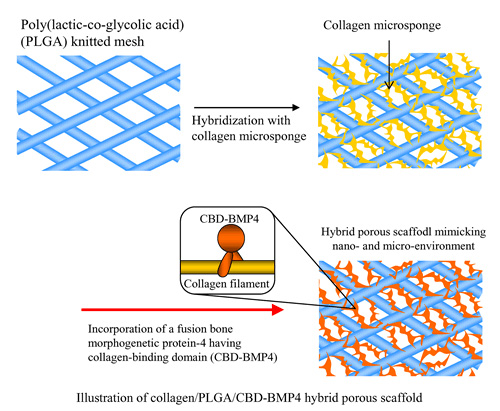- ホーム
- > 研究活動
- > Research Highlights
- > Vol. 3 Bone tissue engineering: Attac・・・
 Research Highlights
Research Highlights
[Vol. 3]
Bone tissue engineering: Attaching proteins for better regeneration
Researchers in Japan demonstrate a new protein binding approach for effectively promoting bone regeneration. Current treatments for bone defects and bone tissue regeneration have significant limitations. Now a new method that immobilizes a fusion protein in a hybrid collagen-polymer supportive scaffold shows promise for bone tissue engineering.

Guoping Chen, and Naoki Kawazoe at the Tissue Regeneration Materials Unit, International Center for Materials Nanoarchitectonics (MANA), National Institute for Materials Science, and researchers at RIKEN, the Immuno-Biological Laboratories Co., Ltd, and the National Institute for Child Health and Development added a collagen-binding domain from fibronectin to BMP4, a protein that promotes bone regeneration. The new fusion protein, BMP4-CBD, was immobilized in a hybrid scaffold of natural collagen sponge and a strong synthetic polymer, poly(lactic-co-glycolic acid) (PLGA). The hybrid scaffold provides space and support for the bone cell growth.
The researchers investigated the effect of BMP4-CBD immobilized in the collagen-PLGA scaffold by in vivo implantationfor four weeks. They compared the approach with a range of controls including scaffolds with wild-type BMP4 without the collagen-binding domain and scaffolds with just the collagen-binding domain. The expression of specific osteogenetic markers used as indicators of bone tissue regeneration was much higher for BMP4-CBD-immobilized hybrid scaffolds. Using BMP4-CBD also promoted calcification.
"These effects should be attributed to the retention of more effective molecules due to the specific binding of the fusion BMP4 to the collagen," say the authors. The stimulation effect of the protein promoting the bone regeneration is thus maintained over a longer period. The research may benefit patients suffering from bone defects in the future.
Reference
"Spatial immobilization of bone morphogenetic protein-4 in a collagen-PLGA hybrid scaffold for enhanced osteoinductivity"
Hongxu Lu, Naoki Kawazoe, Takashi Kitajima, Yuka Myoken, Masahiro Tomita, Akihiro Umezawa, Guoping Chen, and Yoshihiro Ito
Journal: Biomaterials. 33, 6140–6146 (2011) [26 September 2012]
DOI : 10.1016/j.biomaterials.2012.05.038
Hongxu Lu, Naoki Kawazoe, Takashi Kitajima, Yuka Myoken, Masahiro Tomita, Akihiro Umezawa, Guoping Chen, and Yoshihiro Ito
Journal: Biomaterials. 33, 6140–6146 (2011) [26 September 2012]
DOI : 10.1016/j.biomaterials.2012.05.038
Affiliations
International Center for Materials Nanoarchitectonics (WPI-MANA), National Institute for Materials Science (NIMS), Namiki 1-1, Tsukuba, Ibaraki 305-0044, Japan
Contact information
ナノアーキテクトニクス材料研究センター(MANA)
〒305-0044 茨城県つくば市並木1-1
TEL: 029-860-4710
E-mail: mana-pr=ml.nims.go.jp([ = ] → [ @ ] )
TEL: 029-860-4710
E-mail: mana-pr=ml.nims.go.jp([ = ] → [ @ ] )

